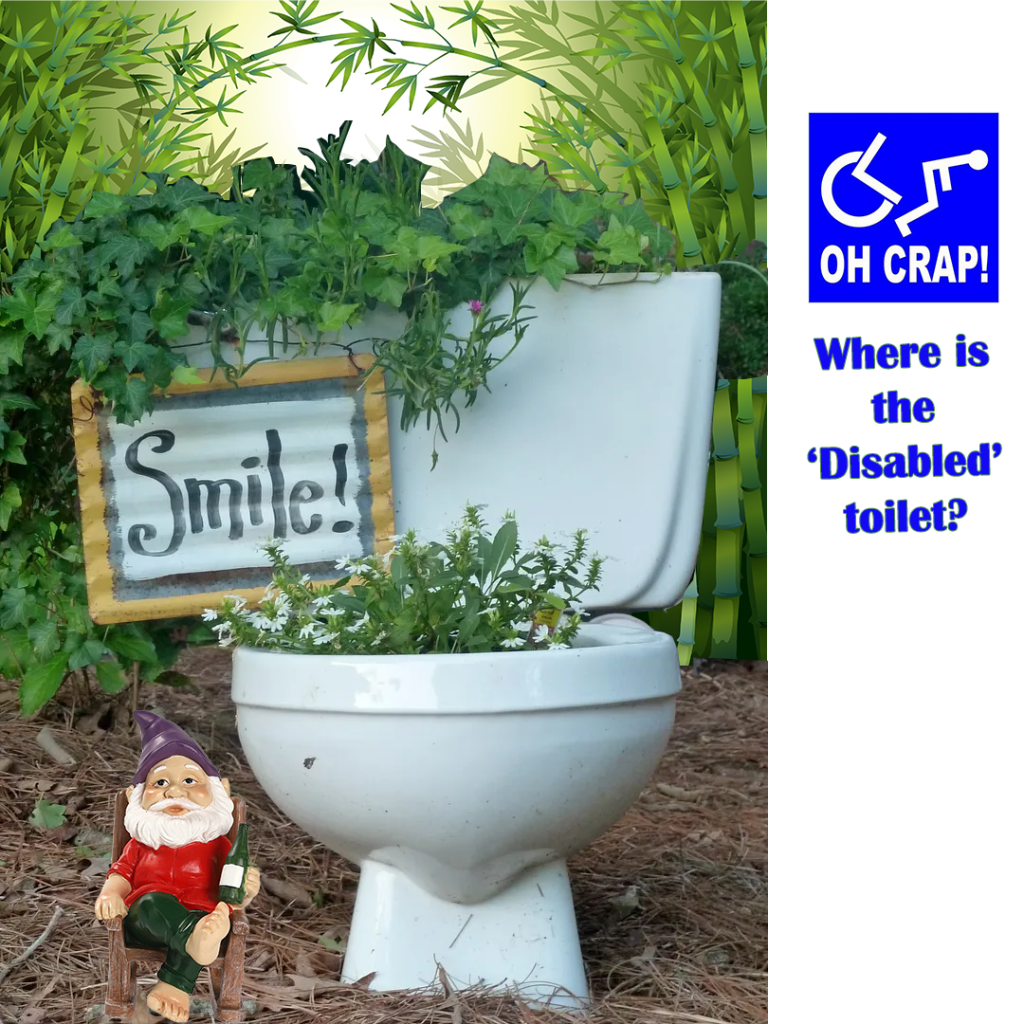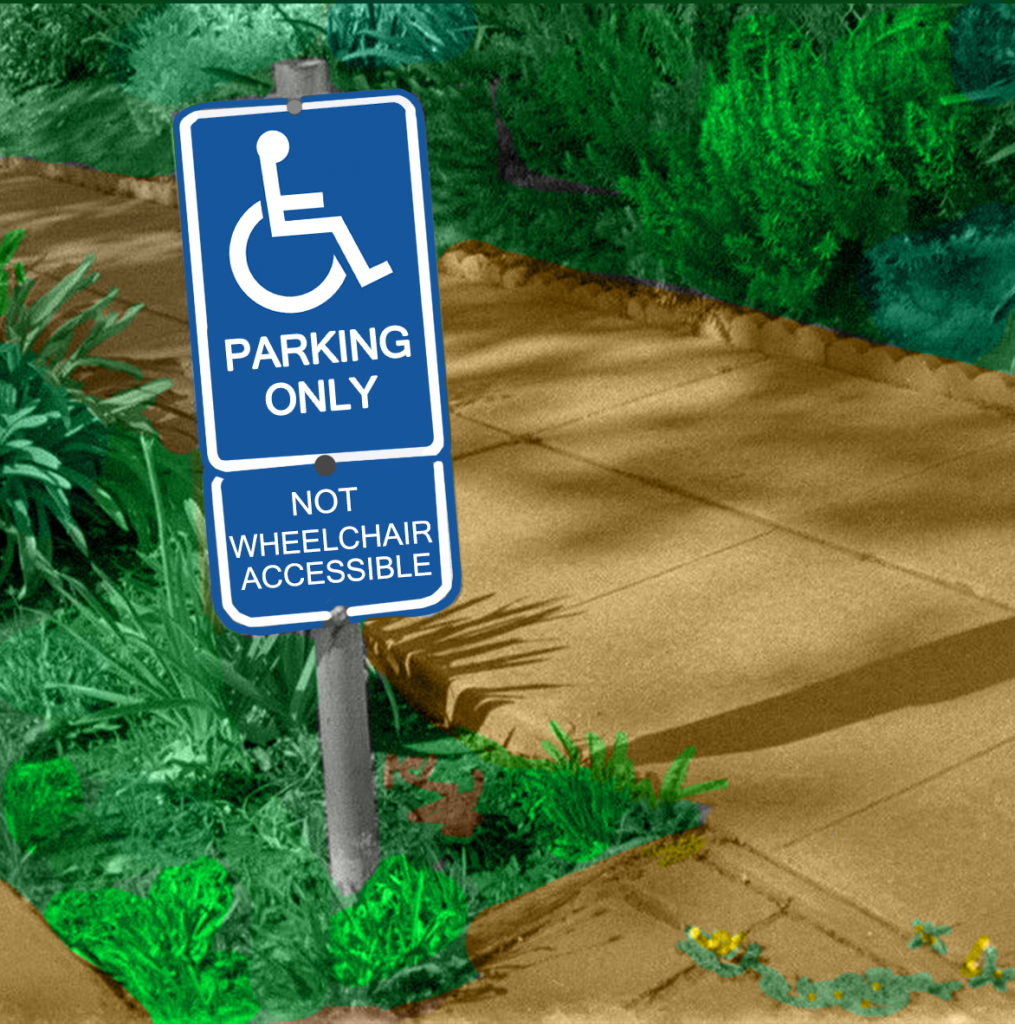
In between lockdowns, I spent the weekend with friends on the Bellarine Peninsula. We went out to lunch at a very popular vineyard. After I had eaten a delicious meal and enjoyed some fine wine I went to the toilet. Nothing strange or unusual about that. Do you expect anything to happen when you go to the toilet except go, then wash your hands maybe see someone and say hi and leave?
On this occasion, while I was standing at the basin washing my hands a woman came in and walked past me and looked around, then looked at me questionably and said, “I am looking for the disabled toilets.”, appearing frazzled she then walked out.
Now come on, an in your face coincidence or what? Why was I there at the same time as this woman came in looking for the disabled toilet? Where the disabled toilets are does not matter to me anymore, I do not need to find where the disabled toilet is anymore, but this incident reminded me of past trauma events and that other people still do need to know where the toilet for a wheelchair users is.
One can assume that the wheelchair user toilet was hidden away somewhere in the building that is hard to find. That no directions were given to the wheelchair user when they arrived. That is if the venue had a wheelchair user toilet. But it was 2021, the venue must have one. Surely that is covered in the human rights law. Maybe the wheelchair user toilet was in the other building. We were in the café, maybe the wheelchair user toilet was in the newer building that housed the restaurant?
Who knows? Who really cares? A Royal Commission into disability was not been set up to even look at, nevertheless consider and address such small yet significant traumatic inclusion issues as this.
More recently, I was having a conversation with a long term friend who has been a paraplegic for over 50 years. Her very expensive manual wheelchair is fold up equipment. She let me know she had spent a couple of days in hospital due to an infection. To go home she required the assistance of a patient mover ambulance. In 2021, one would assume that patient transfer paramedics would be aware of the needs of a paraplegic being transported from one destination to another. In this case a public hospital to home.
After transferring my friend via a hoist into the ambulance vehicle they were about to hit the road when my friend asked where her wheelchair was. She was advised they could not transport her wheelchair as well as her in the ambulance. The wheelchair would have to be left at the hospital until it could be transported to her home another way. “Like hell my personal wheelchair is going to be left behind at a public hospital! I require it to travel with me.” she proclaimed.
What did these professionally trained people think? That she would be able to magically get up and walk once home? After a humiliating, demeaning, and frustrating discussion her wheelchair was allowed to travel home with her in the patient transport vehicle.
Even though the ambulance professionals knew this woman was incapable of standing up or walking unaided they did not see or understand the importance of her wheelchair in her normal life.
In an inclusive society this everyday type of trauma would not exist.
Again the Royal Commission into disability was not set up to address such small yet significant traumatic inclusion issues as this. These situations relate to one person at a time, not a group in an institutional setting.
Human memory is not static. When one remembers one normally is remembering a last memory of an event. Over time little bits are added to the memory scene. The facts can get lost or fuzzy. Soon one can forget how much of the event was real and how much is an add on. When one looks at complex trauma it is important to distinguish how much is a memory and how much is an add on.
Not ‘feeling’ included does not mean that a person has been excluded, it simply means that the person ‘feels’ that they have not been included, usually because of a personal expectation or belief or identity that may or may not be tangible or substantial or quantifiable.
The pain one experiences when one feels that they have been excluded is a real and raw emotion. Left unattended the pain can become a residual unidentified loss. The opportunity for grief to weave healing power is missed. A sensation of emptiness and isolation creeps in. Consequentially, over time the backdrop becomes depression and long term trauma. Behaviour changes, reactions change, and memories re-emerge in repeated common theme nightmares. Self-harm temptations materialise into real action.
The will to die can engulf the will to live and the end result can be a plaque on a cemetery wall.
Inclusion, exclusion paints a vivid picture… yes, I get and accept, that the Royal Commission into disability had all the ‘power’ and ‘control’ of what information is publicly communicated to the outside world in their process. The phrase ‘cherry picking’ of information and sensational ‘First Nation cases’ in certain settings comes to the front of my mind.
A lot of important decisions are made based on survey results and small sample size responses.
Here is a joke Joyce:
What’s red and green and sits up in a tree looking silly?
A mentally retarded apple.
Is this joke’s answer less offensive?
What’s red and green and sits up in a tree looking silly?
An intellectually disabled apple.
Does the picture of the apple sitting in the tree change in your mind as a result of the change of wording?

Mental retardation or the “offensive R” word can be defined as a cognitive ability that is markedly below average level with a decreased ability to adapt to one’s environment.
Intellectual disability is a very broad term and includes problems in both intellectual and adaptive functioning identified as mild, moderate, or severe.
It is dangerous to pretend that someone with a medically diagnosed deficit in cognitive capacity can hide their condition behind a broad all-inclusive social model of disability label dressed up as modern respectful terminology. But the new terminology does welcome the inclusion of a lot more people into the disabled by society world.
In 2013, in America, when the population was 316 million people, a Notice of proposed rule-making had a response of 76 comments. 71 commentators enthusiastically supported the proposal and was the justification for the replacement of the term “mental retardation” with “intellectual disability” in the Social Security Listing of Impairments.
71 out of 76 responders from the public, in a country with 316 million people, provided a 93% approval rating in support of the change in terminology. Sounds like the majority of the population was behind the push for the use of “modern, respectful language” that “allows an individual to escape ‘labelling’” and would “give this population the respect and dignity they deserve” and the change in terminology would “help fight stigma”. Right?
The rules were implemented as proposed because the bureaucrats got the high percentage approval they were seeking, notwithstanding, from a very minuscule number of the population. Nod, Nod! Wink, Wink!
Three parents of adult children with profound cerebral and developmental disabilities, in responses asked that the Social Security Administration not replace “mental retardation” with the term “intellectual disability”.
Albeit the parental concerns were dismissed. The parents regarded “mental retardation” as the medical term that best described their children’s conditions. These parents expressed concern about the “imprecise and vague” nature of the term “intellectual disability.” They feared that the loss of the term “mental retardation” could contribute to a lessening of public awareness and concern for individuals like their children and possibly the elimination of the public institutional service support systems that their children required.
Surveys can be dangerous and damaging research tools when used to settle a preferred course of action. To settle an argument so to speak. Completing a survey can make people believe that their opinion is being sought because it is important, correct, and it will be listened to. Whereas often the truth is an activist advocate is seeking confirmation of their manipulated data or opinion for self-motivated purposes.
Surveys are as easy as pie to create, often effortless to distribute, and the results are a straightforward tally. Surveys are often used to lead people to answer questions designed to create an atmosphere of correct directional schema set by the designer and message seller. The person with the microphone.
“78% of people surveyed said that…” or did they merely answer a very directed question without much choice variation? Yet the 78% of people response becomes spouted as factual evidence to be used by decision makers.
The increased danger with surveys is that you can get very large data sets that make people more likely to believe and quote them. For example, a minor political party thought to be gaining popularity with voters in a survey instead of being named is lumped in the ‘others’ box so not to invite any public awareness of their gaining popularity. Or take the focus of the survey away from a discussion about which one of the two major parties will win the next election. Surveys can be used to determine ‘conditions’ that are
Not a joke Joyce, another true story…
Get this for a real life 2022 example: A full time wheelchair user is employed as an inclusion and diversity officer at a government agency. A face to face meeting to discuss the annual strategic plan was organised. The wheelchair user received a phone call from the organiser asking if they would mind doing the meeting via zoom. Why? Because the room that was booked was on the second floor in a building that had no lift access. Then as the internet connection was not available at the scheduled time of the meeting the wheelchair user was totally excluded from the inclusion and diversity meeting.

In today’s world inclusion is not seen a natural process based on empathy and kindness that will ensure a gateway that embraces all people. Surveys and changing language will not assist either.
Inclusion sanctions will never change attitudes but will divide society into “us” and “them” groups. The excluded group is invited in by the included group as an add on or afterthought.